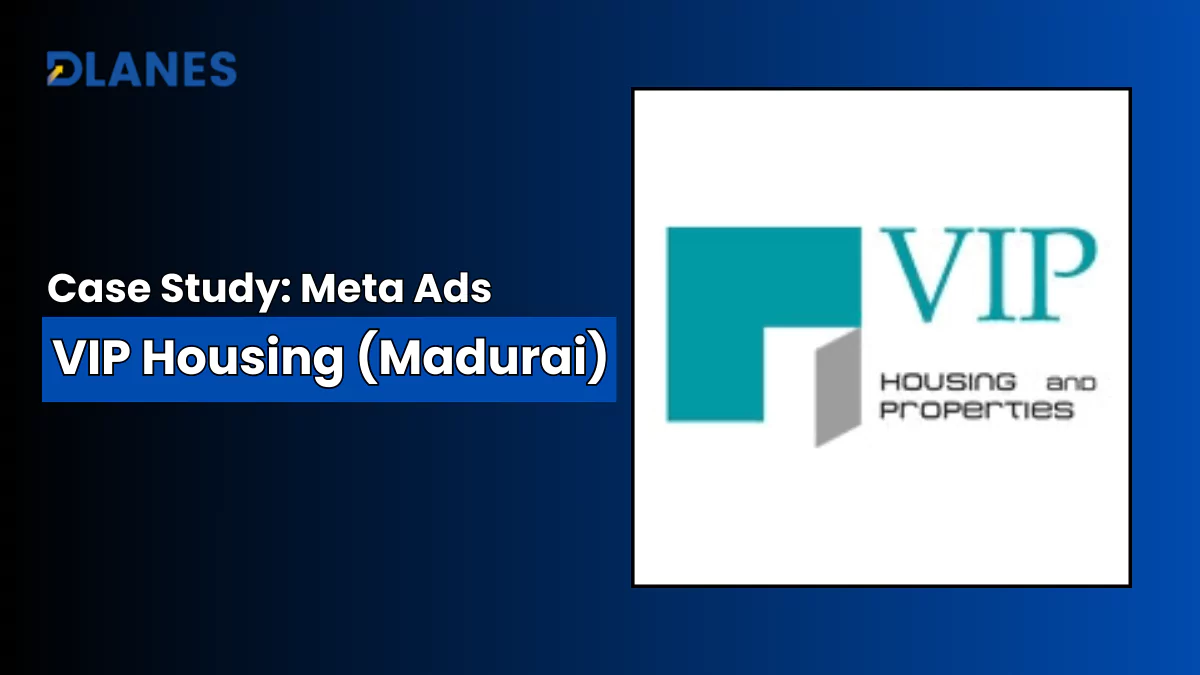How We Reduced Cost Per Lead from ₹216 to ₹113 for VIP Housing

By Team Dlanes
Table of Contents
How We Reduced Cost Per Lead from ₹216 to ₹113 for VIP Housing within a week and 4 site visits were booked out of 13 leads.
Reducing the cost per lead (CPL) is crucial for any marketing campaign, particularly in the competitive real estate industry. Our VIP Housing’s recent campaign demonstrates how strategic adjustments and data-driven decisions can effectively lower CPL while maintaining the quality and quantity of leads. This case study explores the steps how we took to reduce their CPL from ₹216.34 to ₹113.99.
Campaign Overview
- Client: VIP Housing ( Madurai )
- Project: VIP Housing Residential Plots
- Target Area: 30 KM radius, encompassing three towns within 5 KM each
Campaign Performance
| Metric | Value |
|---|---|
| Reach | 16,993 |
| Impressions | 23,173 |
| Meta Leads | 13 |
| Cost Per Lead (CPL) | ₹113.99 |
| Total Amount Spent | ₹1,481.85 |
| CPM (Cost per 1,000 Impressions) | ₹63.95 |
| Click-Through Rate (CTR) | 1.33% |
| Link Clicks | 308 |
| Cost Per Click (CPC) | ₹4.81 |
Analysis and Strategy
Initial Challenges
Despite achieving good reach and engagement in the first week, our Cost Per Lead (CPL) was high at ₹216.34. The challenge was to reduce this cost while maintaining or increasing the number of leads.
Steps to Reduce CPL
- Audience Refinement:
- We analyzed the demographics and interests of their audience in depth. They then refined their targeting to focus on specific segments that showed higher engagement rates, which helped in optimizing ad delivery to those more likely to convert into leads.
- Creative Optimization:
- Conducted A/B testing on different ad creatives to identify the most compelling combinations of visuals and text. This process helped in selecting the ads that resonated best with their target audience, leading to higher engagement and conversion rates.
- Bid Strategy Adjustment:
- Various bid strategies, including manual bidding, were experimented with to control costs more precisely. This allowed us to find the optimal balance between cost and visibility.
- Enhanced Targeting:
- Insights from the first week’s performance were used to fine-tune targeting parameters. By focusing on audience segments that provided better engagement, the campaign improved in relevance and efficiency.
- Continuous Monitoring and Real-time Adjustments:
- The campaign was continuously monitored, allowing for real-time adjustments. This proactive approach ensured that any underperforming elements were quickly addressed, leading to better overall performance.
Results
Through these strategic adjustments, we successfully reduced our CPL from ₹216.34 to ₹113.99. The refined targeting, creative optimization, and strategic bid adjustments were instrumental in achieving these results.
Conclusion
Our campaign exemplifies how careful planning, continuous monitoring, and strategic adjustments can lead to significant cost savings and improved campaign efficiency. By focusing on data-driven decisions and audience insights, we managed to lower our CPL dramatically, making our marketing efforts more cost-effective and impactful.
This case study highlights the importance of adaptive strategies in digital marketing. For real estate marketers aiming to optimize their campaigns, our approach provides valuable lessons in achieving cost-effective lead generation.


